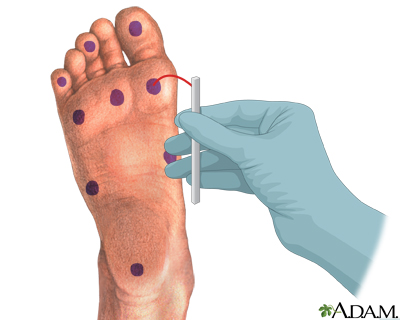Nerve damage from diabetes - self-care
Diabetic neuropathy - self-care
Images

I Would Like to Learn About:
Description
People with diabetes can have nerve problems. This condition is called diabetic neuropathy.
Diabetic neuropathy can happen when you have even mildly high blood sugar levels over a long time. This causes damage to the nerves that go to your:
- Feet and legs
- Hands and arms
- Digestive tract
- Heart
- Bladder
The nerve damage can cause many different problems in your body.
Symptoms
Tingling or burning in the feet and legs may be an early sign of nerve damage in them. These feelings often start in your toes and feet, but can also start in the fingers and hands. You may also have deep pain or aching or just a heavy feeling. Some people may have very sweaty or very dry feet from nerve damage.
Nerve damage may cause you to lose feeling in your feet and legs. Because of this, you may:
- Not notice when you step on something sharp
- Not know you have a blister or small wound on your toes
- Not notice when you touch something too hot or too cold
- Be more likely to bump your toes or feet against objects
- Have the joints in your feet more likely to become damaged which can make it harder to walk
- Experience changes in the muscles in your feet which can cause increased pressure on your toes and balls of your feet
- Be more likely to have infections of the skin on your feet and in your toenails
People with diabetes may have problems digesting food. These problems can make your diabetes harder to control. Symptoms of this problem are:
- Feeling full after eating only a small amount of food
- Heartburn and bloating
- Nausea, constipation, or diarrhea
- Swallowing problems
- Throwing up undigested food several hours after a meal
Heart-related problems may include:
- Lightheadedness, or even fainting, when sitting or standing up
- Rapid heart rate
Neuropathy may "hide" angina. This is the warning chest pain for heart disease and heart attack. People with diabetes should learn other warning signs of a heart attack. They are:
- Sudden fatigue
- Sweating
- Shortness of breath
- Nausea and vomiting
Other symptoms of nerve damage are:
- Sexual problems. Men may have problems with erections. Women may have trouble with vaginal dryness or orgasm.
- Not being able to tell when your blood sugar gets too low ("hypoglycemia unawareness").
- Bladder problems. You may leak urine. You may not be able to tell when your bladder is full. Some people are not able to empty their bladder.
- Sweating too much. Particularly when the temperature is cool, when you are at rest, or at other unusual times.
Treating and Preventing Nerve Damage from Diabetes
Treating diabetic neuropathy can make some symptoms of nerve problems better. The best way to keep the problem from getting worse is to have good control of your blood sugar.
Your health care provider can give you medicines to help with some of these symptoms.
- Medicines may help reduce painful symptoms in the feet, legs, and arms. They usually do not bring back loss of feeling. You may have to try different medicines to find one that reduces your pain. Some medicines will not be very effective if your blood sugars are still very high.
- Your provider may give you medicines to help with problems digesting food or having a bowel movement.
- Other medicines can help with erection problems.
Learn how to take care of your feet. Ask your provider:
- To check your feet. These exams can find small injuries or infections. They can also keep foot injuries from getting worse.
- About ways to protect your feet if the skin is very dry, such as using a skin moisturizer.
- To teach you how to check for foot problems at home and what you should do when you spot problems.
- To recommend shoes and socks that are right for you.
References
American Diabetes Association Professional Practice Committee. 12. Retinopathy, neuropathy, and foot care: standards of care in diabetes-2024. Diabetes Care. 2024;47(Suppl 1):S231-S243. PMID: 38078577 pubmed.ncbi.nlm.nih.gov/38078577/.
Brownlee M, Aiello LP, Sun JK, et al. Complications of diabetes mellitus. In: Melmed S, Auchus, RJ, Goldfine AB, Koenig RJ, Kopp PA, eds. Williams Textbook of Endocrinology. 15th ed. Philadelphia, PA: Elsevier; 2025:chap 38.
Zilliox LA, Chandrasekaran K, Russel JW. Strategies for the prevention of reversal of neuropathy. In: Tavakoli M, ed. Diabetic Neuropathy. 14th ed. Philadelphia, PA: Elsevier; 2022:chap 37.
BACK TO TOPReview Date: 7/21/2024
Reviewed By: Sandeep K. Dhaliwal, MD, board-certified in Diabetes, Endocrinology, and Metabolism, Springfield, VA. Also reviewed by David C. Dugdale, MD, Medical Director, Brenda Conaway, Editorial Director, and the A.D.A.M. Editorial team.

Health Content Provider
06/01/2025
|
A.D.A.M., Inc. is accredited by URAC, for Health Content Provider (www.urac.org). URAC's accreditation program is an independent audit to verify that A.D.A.M. follows rigorous standards of quality and accountability. A.D.A.M. is among the first to achieve this important distinction for online health information and services. Learn more about A.D.A.M.'s editorial policy, editorial process and privacy policy. A.D.A.M. is also a founding member of Hi-Ethics. This site complied with the HONcode standard for trustworthy health information from 1995 to 2022, after which HON (Health On the Net, a not-for-profit organization that promoted transparent and reliable health information online) was discontinued. |
The information provided herein should not be used during any medical emergency or for the diagnosis or treatment of any medical condition. A licensed medical professional should be consulted for diagnosis and treatment of any and all medical conditions. Links to other sites are provided for information only -- they do not constitute endorsements of those other sites. © 1997- 2025 A.D.A.M., a business unit of Ebix, Inc. Any duplication or distribution of the information contained herein is strictly prohibited.
